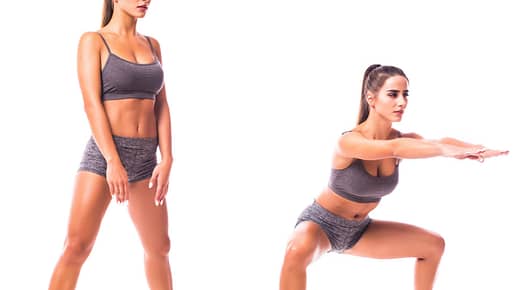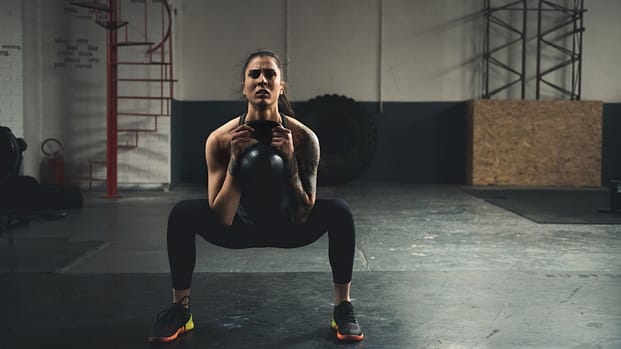Table of Contents
ToggleThe Importance of Targeting the Piriformis
The piriformis muscle can often become tight or tense, leading to discomfort or even pain, especially if you’re sitting for prolonged periods. Strengthening this muscle can help alleviate such issues and improve overall lower body stability.
Squat Variations for the Piriformis
1. Sumo Squats:
This wide-stance squat targets the inner thighs and engages the piriformis. By positioning the feet wider than shoulder-width apart and turning the toes slightly outward, you create an ideal setup to engage this muscle group.

2. Goblet Squats:
Holding a kettlebell or dumbbell close to the chest while performing squats helps engage the piriformis. The key is to maintain proper form, ensuring the knees track over the toes and avoiding inward collapsing.

3. Ballet Squats (Plie Squats):
Similar to sumo squats, these involve a wider stance with toes turned out further, targeting the inner thighs and the piriformis effectively.

Additional Tips for Targeting the Piriformis
Focus on Depth: Ensure proper squat depth without compromising form. This allows the engagement of the piriformis while activating other leg muscles.
Mindful Movement: Concentrate on the outward rotation of the thighs during these squat variations to emphasize the work on the piriformis.
Stretching: Combine squats with stretching exercises targeting the piriformis, such as the pigeon pose or seated piriformis stretch, to improve flexibility and prevent muscle tightness.
So.
Incorporating specific squat variations can effectively target the piriformis muscle, aiding in its strengthening and flexibility. Remember to maintain proper form and focus on engaging the targeted muscle group to maximize the benefits. Strengthening the piriformis not only supports overall lower body strength but also contributes to better hip stability and alleviation of discomfort caused by its tightness.
Fine-Tuning Your Squat Routine for Piriformis Focus
Mastering the technique and understanding the nuances of these squat variations can amplify their effectiveness in targeting the piriformis muscle.
Perfecting Form for Piriformis Engagement
Alignment Matters: Maintain proper alignment throughout the movement. Ensure your knees don’t collapse inward but rather track in line with your toes to engage the piriformis effectively.
Engage Core Muscles: A strong core enhances stability during squats. Engaging the core muscles while performing these variations can facilitate better isolation of the piriformis.
Controlled Movements: Slow, controlled movements while descending and ascending during squats ensure optimal muscle engagement, especially in the piriformis.
Progressive Loading and Adaptation
Gradual Progression: Start with bodyweight squats and gradually add resistance through weights or resistance bands. This progression allows the piriformis to adapt to increasing loads, enhancing strength and endurance.
Variation and Adaptability: Experiment with foot positioning and depth to find the sweet spot that maximizes the engagement of your piriformis muscle.
Incorporating Squats Into a Comprehensive Routine
While these squat variations effectively target the piriformis, incorporating them into a well-rounded lower body workout routine can yield comprehensive benefits.
Sample Lower Body Routine:
- Sumo Squats: 3 sets of 12-15 reps
- Goblet Squats: 3 sets of 10-12 reps
- Ballet Squats: 3 sets of 12-15 reps
Additional Exercises:
- Pigeon Pose Stretch: Hold for 30 seconds each side
- Seated Piriformis Stretch: Hold for 30 seconds each side
Conclusion
With proper form, focused engagement, and a well-structured routine, these squat variations can significantly target the piriformis muscle, contributing to improved lower body strength, stability, and flexibility.
Remember, consistency is key. Incorporate these squats thoughtfully into your fitness regimen, and over time, you’ll notice enhanced strength and reduced discomfort, courtesy of a well-engaged piriformis muscle.
Resources:
Piriformis Muscle Stretches – Healthline
Importance of Hip Stability – ACE Fitness
Different Squat Variations – Self
Pairing these squat variations with a balanced fitness routine can bring about significant improvements not just in your lower body strength but also in your overall fitness and well-being. Happy squatting and stay strong!
Comparison tabular
Here’s a comparison table highlighting the key aspects of the three squat variations for targeting the piriformis muscle:
| Squat Variation | Foot Position | Muscles Engaged | Key Points |
|---|---|---|---|
| Sumo Squats | Wide stance with toes slightly turned out | * Inner thighs * Quads * Glutes * Piriformis | * Emphasizes inner thigh engagement * Targets the piriformis effectively due to the wide stance |
| Goblet Squats | Shoulder-width stance, toes forward | * Quads * Glutes * Hamstrings * Piriformis | * Involves upper body with weight held close to the chest * Focuses on maintaining alignment for piriformis engagement |
| Ballet Squats | Wide stance with toes significantly turned out | * Inner thighs * Glutes * Quads * Piriformis | * Similar to sumo squats but with more emphasis on inner thighs * Requires significant external rotation of the hips for piriformis activation |
Each variation targets the piriformis and other leg muscles but varies slightly in foot positioning and emphasis on specific muscle groups. Incorporating all three into a workout routine ensures a well-rounded approach to strengthening the piriformis and lower body muscles.
Wrapping up
In the pursuit of strengthening the piriformis muscle, these squat variations stand as pillars of support. By integrating sumo squats, goblet squats, and ballet squats into your workout routine, you can forge a robust lower body foundation while specifically targeting the piriformis.
Remember, each squat variation brings its unique flair to the table, engaging not only the piriformis but also a spectrum of leg muscles, from the inner thighs to the glutes and quads. Paying heed to form, alignment, and controlled movements amplifies their effectiveness, ensuring a focused engagement of the targeted muscle groups.
Pair these exercises with complementary stretches like the pigeon pose and seated piriformis stretch to further enhance flexibility and alleviate tension in the piriformis muscle.
Consistency and progressive adaptation are your allies in this endeavor. Gradually increase resistance, fine-tune your technique, and adapt these exercises to suit your body’s needs, paving the way for a stronger, more resilient lower body.
So, embrace these squat variations as tools in your fitness arsenal, weaving them into your routine to sculpt a stronger, more stable foundation. With dedication and mindful practice, the piriformis will thank you, contributing to improved hip stability and overall lower body prowess.
Remember, your fitness journey is a marathon, not a sprint. Enjoy the process, relish the strength gains, and revel in the positive changes these exercises bring. Here’s to a stronger, more balanced you!
Stay committed, stay strong, and keep squatting towards your goals.

Hey there, it’s Mike Rrsq, the Editor-in-Chief over at Jsquat.com, and I’m absolutely obsessed with all things squat fitness! I’ve been lucky enough to get some serious recognition for my work in this field. With a solid background in the fitness and wellness industry, I’ve been there right from the get-go, helping shape this website into what it is today.
You see, I’m not just the boss around here; I’m also a passionate contributor. I love sharing my insights through my articles, and trust me, they’re not your run-of-the-mill stuff. Each piece I write is a labor of love, filled with my expertise and real-world experience in the fitness universe. So, if you’re into fitness and looking for some inspiration, you’re in the right place!
Related Posts
- Is Squat Good To Gain Muscle At 40? (Explained)
Are you wondering if squat is a good exercise to gain muscle at 40? Read…
- Best 3 most effective squat variations you need for targeting the adductor magnus.
Squat is one of the most effective exercises that you can do to target quads…
- When I Squat: Should I Drink More Milk Or Not To Gain Muscle? (Explained)
Squatting is a popular exercise for building lower body strength and muscle mass. However, many…
- Best 3 Squat Variations that you need for Targeting the Vastus Intermedius
When it comes to sculpting and strengthening the lower body, incorporating various squat variations can…
- The 3 most effective squat variations you need to do for targeting the biceps femoris.
When it comes to strengthening and targeting the biceps femoris, a key muscle in the…
- How 20-year-old can modify their back squat to target specific muscle groups
When you're 20, the world of fitness and strength training holds immense possibilities. Back squats,…
- Why My Leg Muscle Shrink With Squats? (Explained)
Are you wondering why your leg muscle is shrinking with squats? Discover the surprising truth…
- Beat 3 squat patterns you need for targeting the semitendinosus and semimembranosus muscles
Squats are a cornerstone of strength training, engaging various muscle groups across the lower body.…

